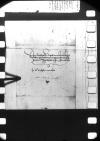Dem erwirdigenn in Goth, unnserm besondern liebenn freundt unnd nachparn, / herrenn ⌊Johansenn bieschoffenn zcu Ermelandt⌋
Unnser freundtlich dienst zuvor. /
Erwirdiger inn Goth, besonnder lieber freundt unnd nachpar. /
Wir habenn Euer Liebdenn ⌊⌋ / belangenndt die beschwer, so der erbar Euer Lieb unthersas ⌊Christoff vonn Wanntkaw⌋ gegenn denn erbarnn unnsernn heuptman zcu ⌊Sehstenn⌋ unnd liebenn getrewenn ⌊Wolffenn Hennicken⌋ / tregt / unnd Euer Lieb supplicationn weiss furgebracht / enntpfangenn unnd lesennde eingenohmenn. / Weil unnss dann sulcher handell unbewust, / so habenn wir obgedachtem unnserm ⌊heuptman⌋ umb bericht desselbenn geschriebenn. / Unnd so baldt der ankumpt wollenn wir Euer Lieb auff ihr ⌊⌋ auffs furderlichst beanttwurtten. Freuntlich bittenndt Euer Lieb wollenn des vertzugks kein beschwer tragenn. / Dann derselbenn freundtlichenn willenn zcuertzeigenn seindt wir idertzeit zcu thun geneigt. /
Datum ⌊Konigsperck⌋, denn 14 Augusti anno etc. im XLI-ten.
Vonn Gots gnadenn ⌊Albrecht marggraff zu ⌊Brandennburgk⌋, / in ⌊Preussenn⌋, / zcu ⌊Stettin⌋, ⌊Pomernn⌋, der ⌊Cassubenn⌋ unnd ⌊Wennden⌋ hertzogk⌋, / burggraffe zcu ⌊Nurenbergk⌋ / unnd furst zcu ⌊Rugenn⌋

